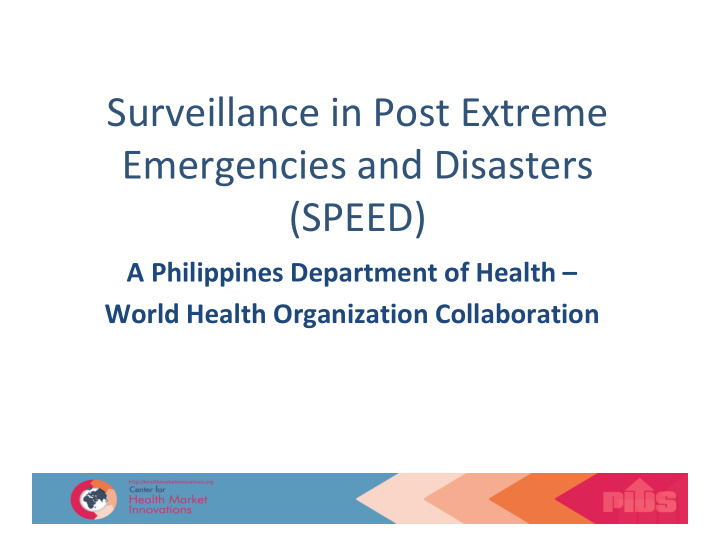



Surveillance in Post Extreme Emergencies and Disasters (SPEED) A Philippines Department of Health – World Health Organization Collaboration
SPEED Program Background- History: • Born from the experiences of past disasters, most especially from Tropical Storm Ondoy and Typhoons Pepeng and Santi in 2009 Massive flooding in National Capital Region, Regions III, IVA Massive displacement and isolation of communities = diseases Delayed reporting + Delayed action = Leptospirosis outbreak post-Ketsana resulting to 3,389 cases with 249 deaths = one of the world’s largest documented outbreaks Key challenge identified: Need for health information system during emergencies and disasters that will give timely information to allow for evidence-based decision- making, and more focused and targeted response.
SPEED Objectives: • Detect early unusual increase in communicable and noncommunicable health conditions • Monitor health trends to determine effectiveness of intervention • Enable identification of appropriate response to handle the emergency Target Beneficiaries: • Ultimate beneficiaries: disaster-affected populations • Immediate beneficiaries: health emergency managers & decision-makers Legal Framework: Republic Act 10121: Phil Disaster Risk Reduction and Mgt Act of 2010 DOH Admin Order 2004-168: National Policy on Health Emergency and Disasters
SPEED Program Mechanism: Milestones • Twenty one (21) health conditions monitored • Standard reporting tools (paper forms, SMS format) • Web-based software to enable easy access to reported data anywhere, anytime • Health facility codes (Ex. Vicente Sotto Memorial Medical Center = HF code is 7CEC001H) • Training materials (interactive to flipcharts) • Capability building – Training for SPEED Reporters, Managers, and Trainers covering 100% of regions, 100% of provinces, 88 % of cities and municipalities; 140 trainers and 4300 managers and reporters
SPEED Program Mechanism: Reporting Flow Action: (1) Immediate interventions (2) Further investigation Consultations at hospitals, RHUs, (3) Intermediate measures BHS, and evacuation centers Use of information by health emergency Accomplishment of appropriate managers at all levels standard SPEED reporting tool Data analysis and report generation Sending of SPEED data in the SPEED at all levels form thru texting/ available modes Validation of cases reported via SPEED Entry of reports into the server c/o MHO/ CHO/ PHO/ CHD RHU – Rural Health Unity / BHS – village health post / MHO – Municipal Health Office / CHO – City Health Office / PHO – Provincial Health Office / CHD – Center for Health Development (DOH office in the region) / DOH-HEMS – Dept of Health – Health Emergency Management Staff (central Office)
SPEED Program Mechanism: Key Players Players Roles Reporters Local health staff/ partners: data collection and reporting Data managers MHO/CHO: data validation, data analysis, report generation and response PHO: LGU monitoring and tech. assistance, data validation and analysis, report generation and response CHD: LGU monitoring and tech. assistance, data validation and analysis, report generation and response Program manager DOH-HEMS: oversees the entire program; provides policy direction; develops guidelines and protocols; report generation for national concerns; national response including mobilization of all logistical requirements and technical assistance
SPEED Program Impact • Real-time reporting at all levels • Facilitate delivery of timely and appropriate intervention • Prioritized and maximized allocation and mobilization of resources • Provision of tools for easier descriptive analysis and report generation • Utilization of health facility codes assignment in other programs • A model for SMS-based reporting systems
Weekly Consultation of Suspected Leptospirosis Cases Dec 19, 2011 – Mar 11, 2012 •1 st suspected leptospirosis consultation reported •Prophylaxis provided to IDPs in ECs and patients with wounds and injuries seen in the hosp. • Consultation of lepto started to rise • Epidemiologic investigation conducted 700 • 3 deaths reported • Peak of consult recorded 600 • Declared Leptospirosis Outbreak • Mobile lepto team conducted massive prophylaxis 500 • Use of rapid diagnostics test • Additional 7 deaths reported 400 •Consultation started to decrease 300 •No additional deaths reported 200 •Declaration by CHD X that lepto outbreak is over 100 0 Dec Dec Jan2-8 Jan9- Jan16- Jan23- Jan 30- Feb 6- Feb 13- Feb 20- Feb 27- March 19-25 26- 15 22 29 Feb 5 12 19 26 Mar 4 5-11 Jan1 CDO Iligan Total Illustrating the impact of SPEED reporting in CDO and Iligan post-Sendong
SPEED Program as an innovation: • It is the world’s first early warning disease surveillance system in times of disasters and emergencies that has ALL of the following characteristics: – With nationwide coverage – Is managed and run entirely by the national government with participation of the local government (institutionalized in the office of the DOH-Health Emergency Management Staff) – Uses easily available, accessible, affordable, acceptable, and very popular technology – SMS or texting – Uses internet-based information management software, making data analysis, report generation, dissemination, and action faster
Recommend
More recommend